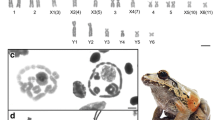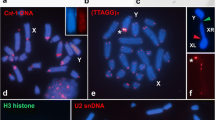Abstract
The morphological and kinetical features of the odonate sex chromosomes are reviewed and trends of the evolution of different modes of sex determination in the order are considered. The cytological conditions in the familyGomphidae are of particular importance for the understanding of the evolution of sex determination in dragonflies and are discussed in detail.
The original mode of sex determination in Odonata is of the XO/XX type, the male being the heterogametic sex, and is observed in all primary complements (cf.Kiauta, 1967) regardless of the chromosome number viz. the degree of phylogenetic advancement and specialisation achieved by the taxons concerned.
The mean length of the sex chromosome and the ratio between the longest autosomal bivalent and X are not characteristic at superspecific taxonomic levels. In the male the sex chromosome is usually positively heteropycnotic at all spermatocyte stages, save metaphase and anaphase, whereas in the female it is nearly without exception isocyclic. The first maturation division is equational for X, the second is reductional.
In secondary complements a neo-XY sex determination occurs, in those cases where the original X was involved in a fusion with an autosome. Its occurrence is not related to phylogeny.
The neo-XY condition is often reversible: it occurs in some cells (or stages) while not in others of the same individual. If stabilised, it tends to evolve further, as it was demonstrated inGomphidae, into a secondary XO type. The process has three stages, with an intermediate neo-X neo-neo-Y sex determination and a final numeric reduction of the diploid complement by two elements.
It was demonstrated, that the present type number ofGomphidae is of secondary rather than of primary origin.
Similar content being viewed by others
References
Asana, J. J. &S. Makino, (1935). A comparative study of the chromosomes in the Indian dragonflies.J. Fac. Sci. Hokkaido Imp. Univ.,VI,4: 67–86.
Bacci, G., (1965).Sex determination. Pergamon Press, Oxford.
Brink, J. M. van &B. Kiauta, (1964). Notes on chromosome behaviour in the spermatogenesis of the damselflyEnallagma cyathigerum (Charp.) (Odonata: Coenagrionidae).Genetica 35: 171–174.
Crew, F. A. E., (1965).Sex determination. Methuen, London.
Cruden, R. W., (1968). Chromosome numbers of some North American dragonflies (Odonata).Canad. J. Genet. Cytol. 10: 200–214.
Cumming, R. B., (1964a).Cytogenetic studies in the order Odonata. Thesis, Univ. of Texas.
Cumming, R. B., (1964b). Cytogenetic studies in the orderOdonata.Dissert. Abstr. 25: 3169–3170.
Darlington, C. D., (1965).Cytology. Churchill, London.
Das, C., (1956). Studies on the association between non-homologous chromosomes during meiosis in four species of the Indian dragonflies (Odonata).J. Zool. Soc. India 8: 119–132.
Dixon, W. J. &F. J. Massey, (1951).Introduction to statistical analysis. McGraw-Hill, New York-Toronto-London.
Fraser, F. C., (1957).A reclassification of the order Odonata. Roy. Zool. Soc., New South Wales.
Fuchsówna, J. &J. Sawczyńska, (1928). Zachowanie sie heterochromosomów podczas spermatogenezy u wažek (Odonata). Cz. IAeschna grandis L. —Libellula quadrimaculata L.Arch. Tow. Nauk. Lwow,III,4: 177–197. (In Polish).
Hirai, H., (1956). Chromosomes of six species of dragonflies.Zool. Mag. (Jap.) 65: 198–202.
Kiauta, B., (1967). Considerations on the evolution of the chromosome complement inOdonata.Genetica 38: 430–446.
Kiauta, B., (1968a). Variation in size of the dragonfly m-chromosome, with considerations on its significance for the chorogeography and taxonomy of the orderOdonata, and notes on the validity of the rule of Reinig.Genetica 39: 64–74.
Kiauta, B., (1968b). Morphology and kinetic behaviour of the odonate sex chromosomes, with a review of the distribution of sex determining mechanisms in the order.Genen en Phaenen 12: 21–24.
Kiauta, B., (1968c). Distribution of the chromosome numbers in Trichoptera in the light of phylogenetic evidence.Genen en Phaenen 12: 110–113.
Kiauta, B. &J. M. van Brink, (1968). Sex chromosomes and sex determining mechanisms in the orderOdonata.Proc. XIIth Int. Congr. Genetics, Tokyo 1: 206.
Kichijo, H., (1939). Chromosomes ofTachopteryx pryeri andGomphus hakiensis (Odonata: Aeshnidae).Jap. J. Genet. 15: 287–289.
Lefevre, G. &C. McGill, (1908). The chromosomes ofAnasa tristis andAnax junius.Amer. J. Anat. 7: 469–487.
Makalowskaja, W. N., (1940). Comparative karyological studies of dragonflies (Odonata).Arch. Russ. anat. hist. embriol. 25: 24–39, 120–121.
McClung, C. E., (1917). The multiple chromosomes ofHesperotettix andMermira.J. Morphol. 29: 519–605.
McGill, C., (1904). The spermatogenesis ofAnax junius.Univ. Missouri Stud. 2: 236–250.
Mittwoch, U., (1967).Sex chromosomes. Academic Press, New York-London.
Oguma, K., (1930). A comparative study of the spermatocyte chromosome in allied species of the dragonfly.J. Fac. Sci. Hokkaido Imp. Univ.,VI,1: 1–32.
Oksala, T., (1943). Zytologische Studien and Odonaten. I. Chromosomenverhältnisse bei der GattungAeschna mit besonderer Berücksichtigung der postreduktionellen Teilung der Bivalente.Ann. Acad. Sci. Fenn. (A),IV,4: 1–64.
Oksala, T., (1945). Zytologische Studien an Odonaten. III. Die Ovogenese.Ann. Acad. Sci. Fenn. (A),IV,9: 1–32.
Omura, T., (1955). A comparative study of the spermatogenesis in the Japanese dragonflies. I. FamilyLibellulidae.Biol. J. Okayama Univ. 2: 95–135.
Omura, T., (1957). A comparative study of the spermatogenesis in the Japanese dragonflies. II. FamiliesAeschnidae, Gomphidae andCalopterygidae.Biol. J. Okayama Univ. 3: 1–86.
Ray Chaudhuri, S. P. &J. Das Gupta, (1949). Cytological studies on the Indian dragonflies. I. Structure and behaviour of chromosomes in six species of dragonflies (Odonata).Proc. Zool. Soc. Bengal 2: 81–93.
Saez, F. A., (1963). Gradient of the heterochromatization in the evolution of the sexual system “neo-X-neo-Y”.Portug. Acta Biol. (A),4: 111–138.
Schrader, F., (1947). The role of the kinetochore in the chromosomal evolution of theHeteroptera andHomoptera.Evolution 1: 134–142.
Seshachar, B. R. &S. Bagga, (1962). Chromosome number and sex-determination mechanism in the dragonflyHemianax ephippiger (Burmeister).Cytologia 27: 443–449.
Smith, E., (1916). Spermatogenesis of the dragonflySympetrum semicinctum (Say) with remarks uponLibellula basalis.Biol. Bull. 31: 269–290.
Srivastava, M. D. L. &C. C. Das, (1953). Heteropycnosis in the autosome segments ofCeriagrion coromandelianum (Odonata).Nature (Lond.) 172: 765.
Toyoshima, H. &H. Hirai, (1953). A study of the chromosomes of four species ofOdonata found in Kagawa Prefecture.Kagawa Biol. 1: 17–19. (In Japanese).
Troedsson, P. H., (1944). The behaviour of the compound sex chromosomes in the famales of certainHemiptera Heteroptera.J. Morphol. 75: 103–147.
White, M. J. D., (1954).Animal cytology and evolution. Cambridge Univ. Press.
Author information
Authors and Affiliations
Rights and permissions
About this article
Cite this article
Kiauta, B. Sex chromosomes and sex determining mechanisms in Odonata, with a review of the cytological conditions in the familyGomphidae, and references to the karyotypic evolution in the order. Genetica 40, 127–157 (1969). https://doi.org/10.1007/BF01787346
Received:
Issue Date:
DOI: https://doi.org/10.1007/BF01787346




